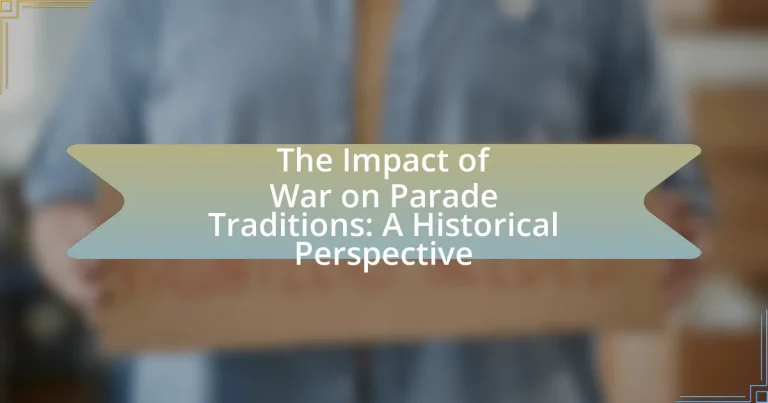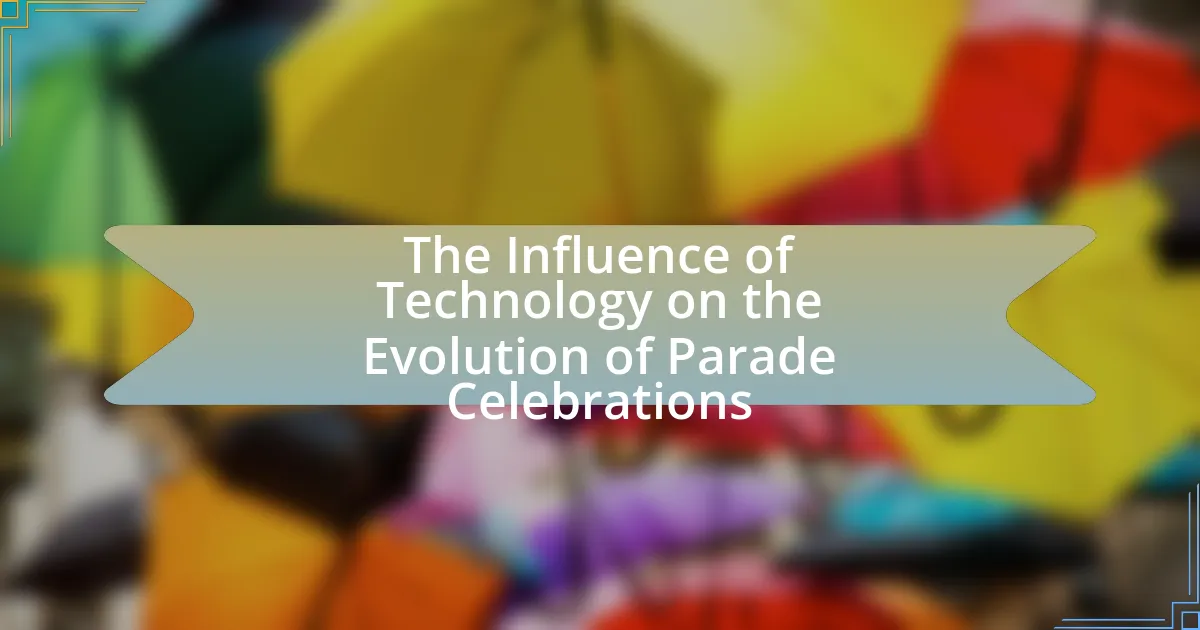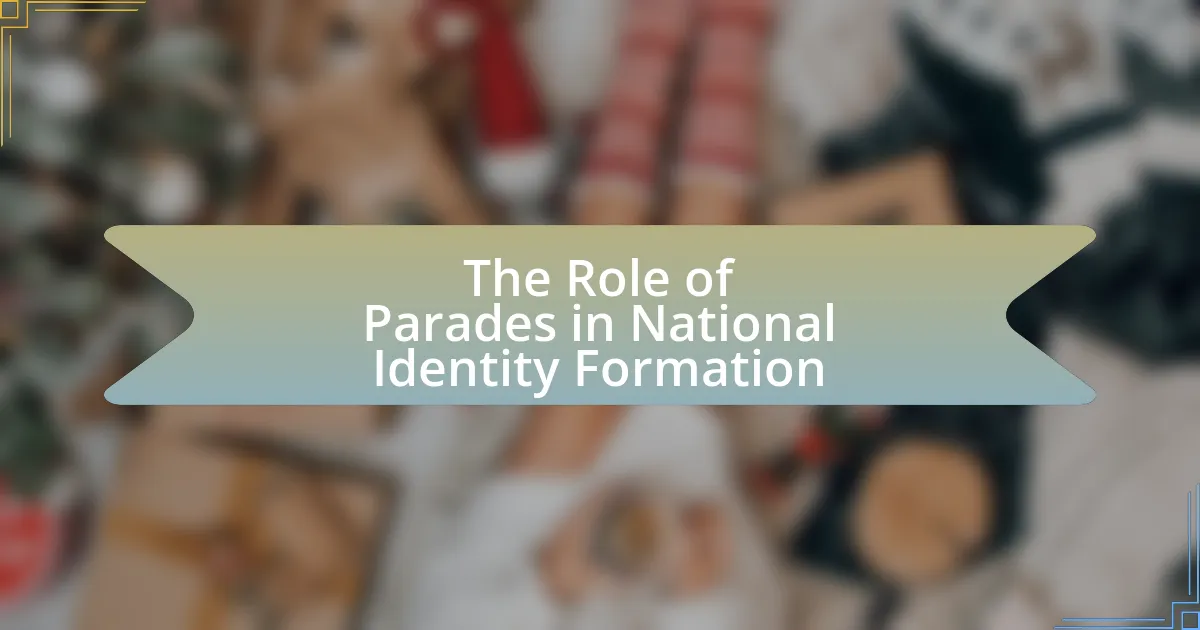The article examines the historical significance of parade traditions in relation to war, highlighting their role in fostering national unity, celebrating military achievements, and commemorating sacrifices. It discusses the evolution of these traditions during conflicts, noting how societal changes and cultural factors shape their themes and practices. Key events, such as World War I and II, are analyzed for their impact on parade customs, illustrating how modern conflicts continue to influence these traditions. The article also addresses the challenges organizers face in maintaining relevance and offers strategies for ensuring that parades honor veterans and reflect contemporary societal values.
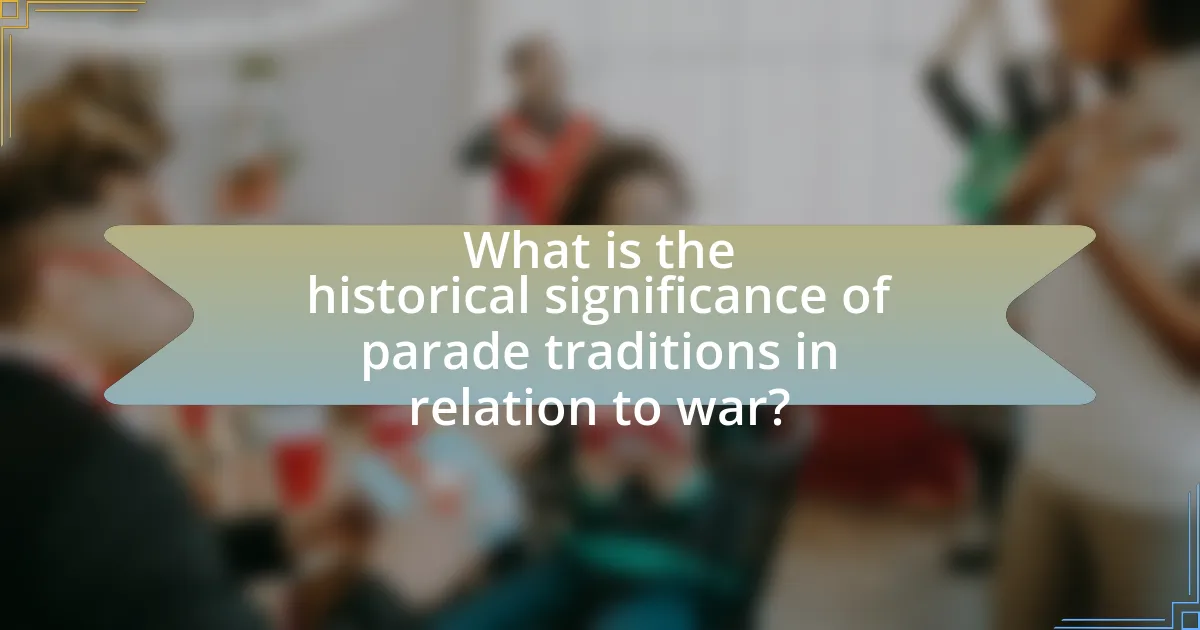
What is the historical significance of parade traditions in relation to war?
Parade traditions hold historical significance in relation to war as they serve as a means of national unity, celebration of military achievements, and commemoration of sacrifices made during conflicts. Throughout history, parades have been utilized to showcase military strength and foster patriotism, exemplified by events such as the Victory Day Parade in Russia, which commemorates the Soviet Union’s triumph over Nazi Germany in World War II. These traditions often reflect societal values and collective memory, reinforcing the importance of military service and sacrifice in shaping national identity. Additionally, parades can act as a platform for political leaders to rally public support and demonstrate power, as seen in various military parades across different nations.
How have parade traditions evolved during times of conflict?
Parade traditions have evolved significantly during times of conflict, often reflecting societal changes and the impact of war on national identity. For instance, during World War I, many countries adapted their parades to honor military sacrifices, incorporating somber elements and memorials to fallen soldiers, which shifted the focus from celebration to commemoration. In World War II, parades became a means of boosting morale, showcasing military strength, and fostering unity among civilians, as seen in the grand Victory Day parades in the Soviet Union, which emphasized national pride and resilience. Additionally, post-conflict parades often included themes of reconciliation and healing, as demonstrated by the annual St. Patrick’s Day parades in Ireland, which evolved to promote peace and inclusivity following decades of conflict. These adaptations illustrate how parade traditions serve not only as cultural expressions but also as reflections of the historical context and collective memory shaped by conflict.
What specific events have influenced changes in parade traditions?
World War I significantly influenced changes in parade traditions by introducing military elements and a focus on national pride. The war prompted nations to incorporate displays of military might and honor fallen soldiers into parades, transforming them from celebratory events into solemn commemorations. For instance, the 1919 Armistice Day parades in various countries featured military processions and tributes to veterans, marking a shift towards a more militarized and patriotic tone in public celebrations. This trend continued through World War II, where parades became platforms for showcasing military achievements and fostering national unity, further embedding these themes into the fabric of parade traditions.
How do cultural factors shape parade traditions in wartime?
Cultural factors significantly shape parade traditions in wartime by influencing the themes, symbols, and community participation in these events. For instance, during World War I and II, parades often incorporated nationalistic themes and symbols of resilience, reflecting the collective identity and morale of the society. Historical examples include the Victory Parades held in various countries post-war, which celebrated military achievements and fostered national unity. Additionally, cultural expressions such as music, attire, and rituals during these parades served to reinforce societal values and collective memory, as seen in the use of patriotic songs and traditional costumes that evoke a sense of pride and remembrance.
Why are parades important for national identity during and after wars?
Parades are important for national identity during and after wars because they serve as public displays of unity, patriotism, and resilience. These events often commemorate sacrifices made by military personnel and reinforce a collective national memory. For instance, the Victory Day Parade in Russia celebrates the defeat of Nazi Germany, fostering a sense of pride and continuity in national identity. Additionally, parades can symbolize recovery and renewal, as seen in the annual Fourth of July celebrations in the United States, which highlight the nation’s independence and strength following conflicts. Such events not only honor the past but also help to unify citizens around shared values and national narratives, thereby solidifying a cohesive national identity.
How do parades serve as a means of collective memory for societies?
Parades serve as a means of collective memory for societies by commemorating significant historical events and fostering a shared identity among participants and spectators. They often celebrate victories, honor sacrifices, and reinforce cultural narratives, which helps to solidify a community’s historical consciousness. For example, military parades following wars, such as the Victory Day Parade in Russia, not only celebrate military achievements but also serve to remember the sacrifices made during conflicts, thereby embedding these memories into the national identity. This collective remembrance is crucial for societal cohesion, as it allows individuals to connect with their shared past and understand their place within the larger historical context.
What role do parades play in the healing process after conflicts?
Parades serve as a vital mechanism for community healing after conflicts by fostering unity and collective remembrance. They provide a platform for individuals to express shared grief, celebrate resilience, and honor those affected by the conflict. Historical examples, such as the parades held in cities like Berlin after World War II, illustrate how these events can help restore a sense of normalcy and community identity. Additionally, studies have shown that public commemorations, including parades, can significantly contribute to psychological healing by allowing communities to process trauma collectively, thereby reinforcing social bonds and promoting a shared narrative of recovery.
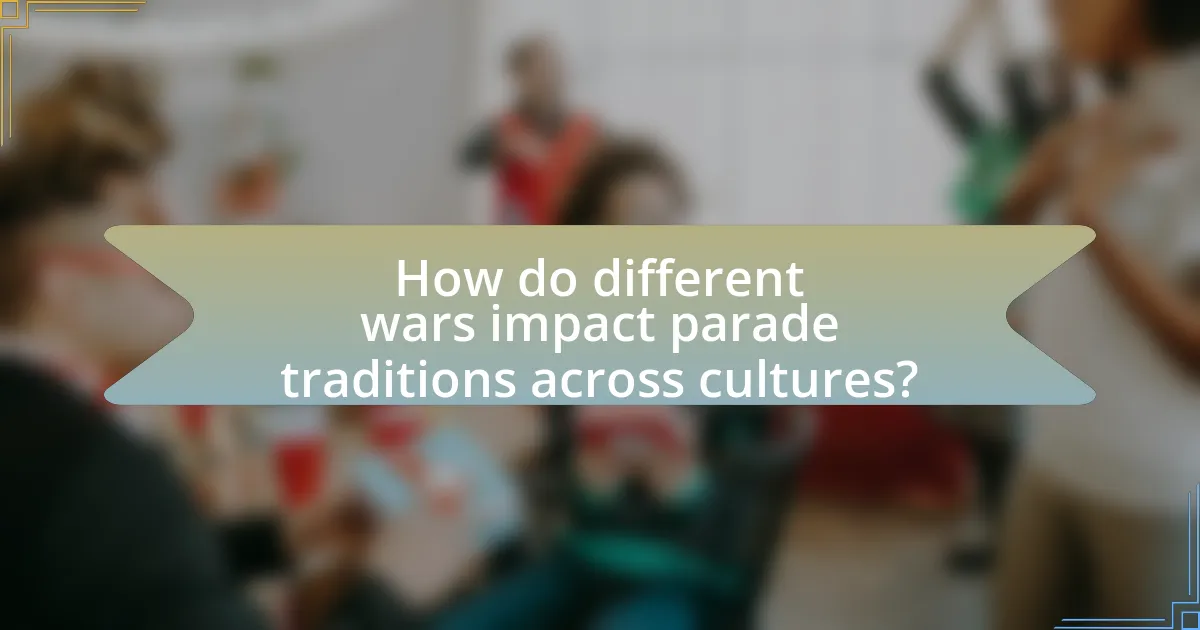
How do different wars impact parade traditions across cultures?
Different wars significantly alter parade traditions across cultures by introducing themes of nationalism, remembrance, and social change. For instance, after World War I, many countries adopted parades to honor fallen soldiers, leading to the establishment of Armistice Day parades, which became a global tradition. In the United States, the Veterans Day Parade evolved from this context, emphasizing gratitude towards military service. Similarly, in countries like France, the Bastille Day parade reflects national pride and military strength, particularly after conflicts like World War II, reinforcing a sense of unity and resilience. These adaptations demonstrate how wars shape the cultural significance and purpose of parades, transforming them into platforms for collective memory and national identity.
What are the variations in parade traditions among different countries during wartime?
Parade traditions during wartime vary significantly among countries, reflecting cultural values, historical contexts, and military objectives. For instance, in the United States, parades often emphasize patriotism and community support for troops, exemplified by events like the Veterans Day Parade, which honors military service and sacrifices. In contrast, Russia’s Victory Day Parade showcases military might and national pride, featuring extensive displays of military hardware and troops marching through Red Square, commemorating the defeat of Nazi Germany in World War II. Similarly, France’s Bastille Day Parade emphasizes national unity and historical significance, celebrating the French Revolution with a military procession along the Champs-Élysées. These variations illustrate how each nation adapts its parade traditions to reflect its unique historical experiences and societal values during times of conflict.
How do historical contexts influence these variations?
Historical contexts significantly influence variations in parade traditions by shaping the themes, symbols, and practices reflected in these events. For instance, during World War I and II, many nations adapted their parades to honor military sacrifices, incorporating military displays and patriotic motifs that resonated with the public’s sentiments of loss and pride. This adaptation is evident in the United States, where the Veterans Day Parade evolved to commemorate those who served, reflecting the historical context of wartime experiences and national identity. Additionally, post-war periods often saw parades shift towards celebration and reconciliation, as seen in the 1945 Victory Day Parade in Moscow, which emphasized national unity and triumph. These examples illustrate how historical events directly inform the content and character of parade traditions, making them dynamic reflections of societal values and historical narratives.
What examples illustrate the differences in parade traditions during specific wars?
During World War I, parades often emphasized military might and national unity, exemplified by the 1919 Victory Parade in London, which showcased troops and war machinery to celebrate the end of the conflict. In contrast, World War II parades, such as the 1945 Victory Day Parade in Moscow, were characterized by a display of Soviet power and ideology, featuring large formations of troops and military equipment to demonstrate strength against fascism. These differences highlight how parade traditions evolved to reflect the political and social contexts of each war, with World War I focusing on celebration and remembrance, while World War II emphasized ideological victory and national pride.
How do modern conflicts reshape traditional parade practices?
Modern conflicts significantly reshape traditional parade practices by altering their themes, purposes, and public perceptions. For instance, parades that once celebrated national pride may now focus on themes of remembrance and reconciliation, reflecting the societal impact of war. The annual Veterans Day parades in the United States have evolved to honor not only military achievements but also the sacrifices and challenges faced by veterans, highlighting issues such as PTSD and reintegration into civilian life. Additionally, security concerns stemming from modern conflicts have led to increased regulation and surveillance during parades, changing the atmosphere and accessibility of these events. Historical examples include the transformation of the Bastille Day parade in France, which now incorporates military displays that emphasize national unity and vigilance in the face of terrorism, rather than solely celebrating historical victories.
What innovations have emerged in parade traditions due to contemporary warfare?
Innovations in parade traditions due to contemporary warfare include the incorporation of advanced technology, such as drones and augmented reality, to enhance visual displays and audience engagement. For instance, military parades now often feature unmanned aerial vehicles that provide aerial footage and dynamic light shows, creating a more immersive experience. Additionally, the use of digital screens and live streaming has transformed how parades are experienced, allowing for broader accessibility and real-time updates. These changes reflect a shift towards modernizing traditional celebrations to resonate with contemporary audiences while showcasing military capabilities.
How do technological advancements affect the execution of parades?
Technological advancements significantly enhance the execution of parades by improving logistics, safety, and audience engagement. For instance, the use of drones for aerial photography and live streaming allows for real-time broadcasting, increasing viewer participation and reach. Additionally, advancements in sound and lighting technology create immersive experiences for attendees, making parades more visually and audibly captivating. Furthermore, innovations in transportation and communication streamline the coordination of participants and resources, ensuring smoother operations. Historical examples include the integration of digital displays in parades, which have transformed traditional floats into interactive platforms, showcasing the evolution of parade execution in response to technological progress.
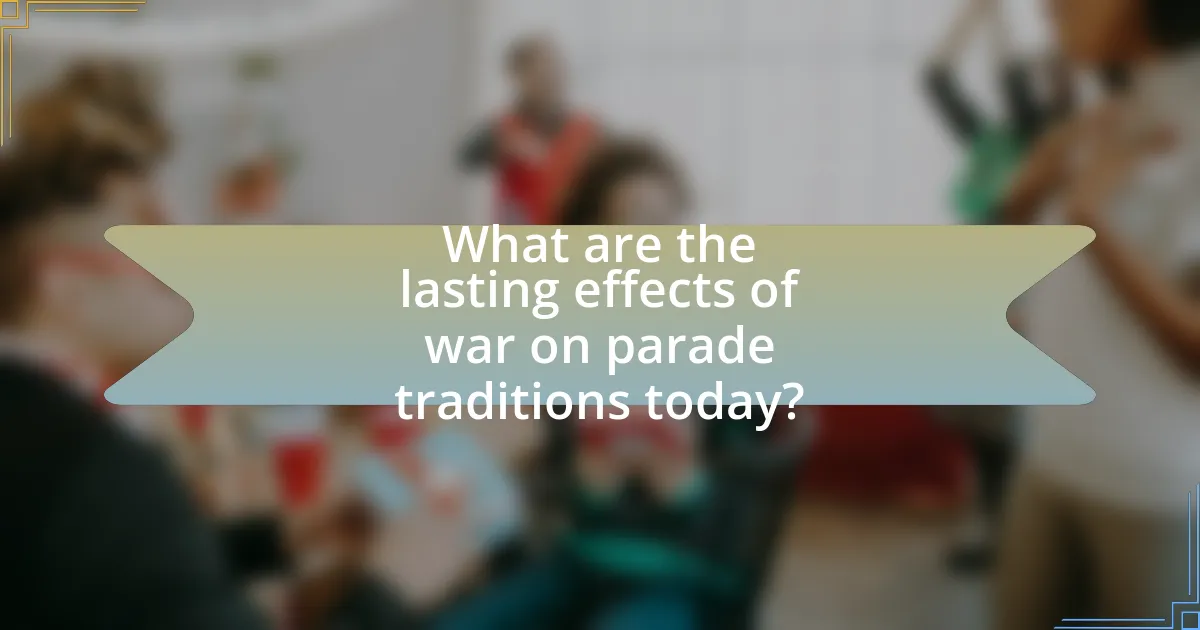
What are the lasting effects of war on parade traditions today?
The lasting effects of war on parade traditions today include the incorporation of military honors and commemorative elements that reflect national pride and remembrance. For instance, many modern parades feature veterans, military displays, and tributes to fallen soldiers, which serve to honor sacrifices made during conflicts. Historical events, such as World War I and II, significantly influenced the evolution of these traditions, leading to the establishment of specific days like Memorial Day in the United States, where parades are held to commemorate those who served. Additionally, the use of patriotic music and symbolism in parades has become a standard practice, reinforcing national identity and collective memory associated with wartime experiences.
How do current parade traditions reflect historical wartime experiences?
Current parade traditions reflect historical wartime experiences by commemorating military sacrifices and fostering national unity. For instance, events like Memorial Day parades in the United States honor fallen soldiers from various conflicts, showcasing military personnel and veterans as symbols of sacrifice. Additionally, the use of military displays, such as marching bands and color guards, serves to evoke a sense of pride and remembrance linked to specific wars, like World War I and II. These traditions often incorporate elements like moments of silence and the playing of national anthems, directly connecting contemporary celebrations to the historical context of conflict and loss.
What elements of past conflicts are still visible in modern parades?
Modern parades prominently feature elements such as military uniforms, ceremonial marches, and symbolic displays that trace their origins to past conflicts. Military uniforms, often worn by participants, reflect the styles and insignia of historical armies, serving as a reminder of the sacrifices made during wars. Ceremonial marches, which include precise formations and disciplined movements, are derived from military drills used in battle, emphasizing order and unity. Additionally, symbolic displays, such as flags and memorials, honor those who served and commemorate significant battles or events, linking contemporary celebrations to historical narratives of conflict. These elements collectively illustrate how the legacy of past wars continues to shape the cultural practices surrounding modern parades.
How do contemporary parades honor veterans and fallen soldiers?
Contemporary parades honor veterans and fallen soldiers through various ceremonial practices, including the display of military honors, participation of veteran organizations, and moments of silence. These parades often feature color guards, military bands, and floats that commemorate specific conflicts, showcasing the sacrifices made by service members. For instance, Memorial Day parades in the United States typically include the laying of wreaths at memorials, which serves as a tribute to those who have died in service. Additionally, many parades incorporate speeches from veterans and community leaders that emphasize the importance of remembrance and gratitude, reinforcing the societal commitment to honor those who served.
What challenges do parade organizers face in maintaining traditions post-war?
Parade organizers face significant challenges in maintaining traditions post-war, primarily due to societal changes, resource limitations, and shifts in public sentiment. Societal changes often lead to altered community values and priorities, making it difficult for organizers to engage participants and audiences who may no longer resonate with traditional themes. Resource limitations arise from reduced funding and sponsorship opportunities, as economic conditions post-war can strain budgets, impacting the scale and quality of parades. Additionally, shifts in public sentiment can result in a reevaluation of the meanings associated with certain traditions, leading to debates over their relevance and appropriateness in a changed social landscape. These factors collectively hinder the ability of parade organizers to uphold established customs and practices.
How do societal attitudes towards war influence parade participation?
Societal attitudes towards war significantly influence parade participation by shaping public sentiment and engagement levels. When a society views war positively, such as during times of national pride or victory, participation in parades often increases as citizens celebrate military achievements and express patriotism. For instance, after World War II, many countries held large parades to honor veterans and commemorate victories, reflecting a collective sense of pride and support for the military. Conversely, during periods of anti-war sentiment, such as during the Vietnam War, parade participation can decline as citizens protest against military actions, leading to demonstrations that oppose rather than celebrate war. This shift in participation is evidenced by the significant anti-war protests that occurred in the late 1960s, which drew large crowds and highlighted societal discontent with military involvement. Thus, societal attitudes directly correlate with the nature and scale of parade participation, influencing whether events are celebratory or protest-oriented.
What strategies can be employed to keep parade traditions relevant in modern society?
To keep parade traditions relevant in modern society, organizers can incorporate contemporary themes and technology into the events. By integrating current social issues, such as diversity and inclusion, parades can resonate with a broader audience, reflecting the values of today’s society. For instance, the inclusion of diverse cultural representations in parades has been shown to enhance community engagement and participation, as seen in events like the New York City Pride Parade, which celebrates LGBTQ+ rights and visibility. Additionally, utilizing social media platforms for promotion and live streaming can attract younger generations, making the traditions more accessible and engaging. Research indicates that events with strong online presence see increased attendance and participation, demonstrating the effectiveness of these strategies in maintaining relevance.
What best practices can be adopted for organizing meaningful war-related parades?
To organize meaningful war-related parades, it is essential to incorporate historical context, community involvement, and respectful representation of veterans. Historical context ensures that the parade honors significant events and sacrifices, such as the commemoration of World War II, which involved over 16 million American service members. Community involvement fosters a sense of unity and purpose, as seen in local parades where schools, veterans’ organizations, and civic groups participate, enhancing the communal spirit. Respectful representation of veterans includes acknowledging diverse experiences and sacrifices, which can be achieved through speeches, displays, and the inclusion of various military branches, reflecting the complexity of war’s impact on society. These practices collectively contribute to a parade that is not only celebratory but also educational and respectful, ensuring that the legacy of those who served is honored appropriately.
